Effects of the Severity of Wildfires on Some Physical-Chemical Soil Properties in a Humid Montane Scrublands Ecosystem in Southern Ecuador
Abstract
1. Introduction
2. Materials and Methods
2.1. Study Area
2.2. Study Design
2.3. Identification and Description of HMs Affected by Wildfires
2.4. Determination of Fire Weather and Severity of Wildfires
2.5. Soil Sampling and Laboratory Analysis
2.6. Statistical Analysis
3. Results
3.1. Effects of the Severity of Wildfires on the Physical Properties of the Soil in Each Contrasted Area
3.2. Effects of Wildfires on Chemical Properties of Soils
3.3. Principal Components (PCA) of Soil Bulk Density and Nutrients, Applied to Burned HMs
4. Discussion
5. Conclusions
Author Contributions
Funding
Institutional Review Board Statement
Informed Consent Statement
Data Availability Statement
Acknowledgments
Conflicts of Interest
References
- Renard, Q.; Pelissier, R.; Ramesh, B.; Kodandapani, N. Environmental susceptibility model for predicting forest fire occurrence in the Western Ghats of India. Int. J. Wildland Fire 2012, 21, 368–379. [Google Scholar] [CrossRef]
- Abatzoglou, J.T.; Kolden, C.A.; Balch, J.K.; Bradley, B.A. Controls on interannual variability in lightning-caused fire activity in the western US. Environ. Res. Lett. 2016, 11, 045005. [Google Scholar] [CrossRef]
- Clarke, H.; Gibson, R.; Cirulis, B.; Bradstock, R.A.; Penman, T.D. Developing and testing models of the drivers of anthropogenic and lightning-caused wildfire ignitions in south-eastern Australia. J. Environ. Manag. 2019, 235, 34–41. [Google Scholar] [CrossRef] [PubMed]
- Ye, J.; Wu, M.; Deng, Z.; Xu, S.; Zhou, R.; Clarke, K.C. Modeling the spatial patterns of human wildfire ignition in Yunnan province, China. Appl. Geogr. 2017, 89, 150–162. [Google Scholar] [CrossRef]
- Benali, A.; Sá, A.C.; Ervilha, A.R.; Trigo, R.M.; Fernandes, P.M.; Pereira, J.M. Fire spread predictions: Sweeping uncertainty under the rug. Sci. Total Environ. 2017, 592, 187–196. [Google Scholar] [CrossRef] [PubMed]
- Abatzoglou, J.T.; Williams, A.P. Impact of anthropogenic climate change on wildfire across western US forests. Proc. Natl. Acad. Sci. USA 2016, 113, 11770–11775. [Google Scholar] [CrossRef]
- Li, Y.; Mickley, L.J.; Liu, P.; Kaplan, J.O. Trends and spatial shifts in lightning fires and smoke concentrations in response to 21st century climate over the national forests and parks of the western United States. Atmos. Chem. Phys. 2020, 20, 8827–8838. [Google Scholar] [CrossRef]
- Filgueiras, B.K.; Peres, C.A.; Iannuzzi, L.; Tabarelli, M.; Leal, I.R. Recovery of dung beetle assemblages in regenerating Caatinga dry forests following slash-and-burn agriculture. For. Ecol. Manag. 2021, 496, 119423. [Google Scholar] [CrossRef]
- Armenteras, D.; González, T.M.; Vargas Ríos, O.; Meza Elizalde, M.C.; Oliveras, I. Incendios en ecosistemas del norte de Suramérica: Avances en la ecología del fuego tropical en Colombia, Ecuador y Perú. Caldasia 2020, 42, 1–16. [Google Scholar] [CrossRef]
- Múgica, L.; Canals, R.M.; San Emeterio, L. Changes in soil nitrogen dynamics caused by prescribed fires in dense gorse lands in SW Pyrenees. Sci. Total Environ. 2018, 639, 175–185. [Google Scholar] [CrossRef]
- Millar, C.I.; Stephenson, N.L. Temperate forest health in an era of emerging megadisturbance. Science 2015, 349, 823–826. [Google Scholar] [CrossRef]
- Bodí, M.B.; Cerdà, A.; Mataix-Solera, J.; Doerr, S.H. Efectos de los incendios forestales en la vegetación y el suelo en la cuenca mediterránea: Revisión bibliográfica. Bol. Asoc. Geógr. Esp. 2012, 33–55. [Google Scholar] [CrossRef]
- Parks, S.A.; Miller, C.; Holsinger, L.M.; Baggett, L.S.; Bird, B.J. Wildland fire limits subsequent fire occurrence. Int. J. Wildland Fire 2015, 25, 182–190. [Google Scholar] [CrossRef]
- Harris, L.; Taylor, A.H. Topography, fuels, and fire exclusion drive fire severity of the Rim Fire in an old-growth mixed-conifer forest, Yosemite National Park, USA. Ecosystems 2015, 18, 1192–1208. [Google Scholar] [CrossRef]
- Lydersen, J.M.; Collins, B.M.; Brooks, M.L.; Matchett, J.R.; Shive, K.L.; Povak, N.A.; Smith, D.F. Evidence of fuels management and fire weather influencing fire severity in an extreme fire event. Ecol. Appl. 2017, 27, 2013–2030. [Google Scholar] [CrossRef]
- Ayoubi, S.; Rabiee, S.; Mosaddeghi, M.R.; Abdi, M.R.; Afshar, F.A. Soil erosion and properties as affected by fire and time after fire events in steep rangelands using 137 Cs technique. Arab. J. Geosci. 2021, 14, 1–12. [Google Scholar] [CrossRef]
- Kavdır, Y.; Ekinci, H.; Yüksel, O.; Mermut, A.R. Soil aggregate stability and 13C CP/MAS-NMR assessment of organic matter in soils influenced by forest wildfires in Çanakkale, Turkey. Geoderma 2005, 129, 219–229. [Google Scholar] [CrossRef]
- Chandra, K.K.; Bhardwaj, A.K. Incidence of forest fire in India and its effect on terrestrial ecosystem dynamics, nutrient and microbial status of soil. Int. J. Res. Agric. For. 2015, 5, 69–78. [Google Scholar]
- Hrelja, I.; Šestak, I.; Bogunović, I. Wildfire impacts on soil physical and chemical properties-a short review of recent studies. Agric. Conspec. Sci. 2020, 85, 293–301. [Google Scholar]
- Keeley, J.E. Fire intensity, fire severity and burn severity: A brief review and suggested usage. Int. J. Wildland Fire 2009, 18, 116–126. [Google Scholar] [CrossRef]
- Richter, C.; Rejmánek, M.; Miller, J.E.; Welch, K.R.; Weeks, J.; Safford, H. The species diversity x fire severity relationship is hump-shaped in semiarid yellow pine and mixed conifer forests. Ecosphere 2019, 10, e02882. [Google Scholar] [CrossRef]
- Moya, D.; González-De Vega, S.; Lozano, E.; García-Orenes, F.; Mataix-Solera, J.; Lucas-Borja, M.E.; de Las Heras, J. The burn severity and plant recovery relationship affect the biological and chemical soil properties of Pinus halepensis Mill. stands in the short and mid-terms after wildfire. J. Environ. Manag. 2019, 235, 250–256. [Google Scholar] [CrossRef] [PubMed]
- Dove, N.C.; Safford, H.D.; Bohlman, G.N.; Estes, B.L.; Hart, S.C. High-severity wildfire leads to multi-decadal impacts on soil biogeochemistry in mixed-conifer forests. Ecol. Appl. 2020, 30, e02072. [Google Scholar] [CrossRef] [PubMed]
- Sulwiński, M.; Mętrak, M.; Wilk, M.; Suska-Malawska, M. Smouldering fire in a nutrient-limited wetland ecosystem: Long-lasting changes in water and soil chemistry facilitate shrub expansion into a drained burned fen. Sci. Total Environ. 2020, 746, 141142. [Google Scholar] [CrossRef]
- Kelly, J.; Ibáñez, T.S.; Santín, C.; Doerr, S.H.; Nilsson, M.C.; Holst, T.; Kljun, N. Boreal forest soil carbon fluxes one year after a wildfire: Effects of burn severity and management. Glob. Chang. Biol. 2021, 27, 4181–4195. [Google Scholar] [CrossRef]
- Jordán, A.; Gordillo-Rivero, Á.J.; García-Moreno, J.; Zavala, L.M.; Granged, A.J.; Gil, J.; Neto-Paixão, H.M. Post-fire evolution of water repellency and aggregate stability in Mediterranean calcareous soils: A 6-year study. Catena 2014, 118, 115–123. [Google Scholar] [CrossRef]
- Pereira, P.; Francos, M.; Brevik, E.C.; Ubeda, X.; Bogunovic, I. Post-fire soil management. Curr. Opin. Environ. Sci. 2018, 5, 26–32. [Google Scholar] [CrossRef]
- Dunnette, P.V.; Higuera, P.E.; McLauchlan, K.K.; Derr, K.M.; Briles, C.E.; Keefe, M.H. Biogeochemical impacts of wildfires over four millennia in a Rocky Mountain subalpine watershed. New Phytol. 2014, 203, 900–912. [Google Scholar] [CrossRef]
- Choromanska, U.; DeLuca, T.H. Prescribed fire alters the impact of wildfire on soil biochemical properties in a ponderosa pine forest. SSSAJ 2001, 65, 232–238. [Google Scholar] [CrossRef]
- Muqaddas, B.; Zhou, X.; Lewis, T.; Wild, C.; Chen, C. Long-term frequent prescribed fire decreases surface soil carbon and nitrogen pools in a wet sclerophyll forest of Southeast Queensland, Australia. Sci. Total Environ. 2015, 536, 39–47. [Google Scholar] [CrossRef]
- Moreno, J.M.; Laguna Defior, C.; Calvo Buendía, E.; Marengo, J.A.; Oswald, Ú. (Eds.) Adaptation to Climate Change Risks in Ibero-American Countries—RIOCCADAPT Report; McGraw Hill: New York, NY, USA, 2020. [Google Scholar]
- Armenteras, D.; Gibbes, C.; Anaya, J.A.; Dávalos, L.M. Integrating remotely sensed fires for predicting deforestation for REDD+. Ecol. Appl. 2017, 27, 1294–1304. [Google Scholar] [CrossRef] [PubMed]
- Bandy, D.; Garrity, D.P.; Sánchez, P. El problema mundial de la agricultura de tala y quema. Agrofor. Am. 1994, 1, 14–20. (In Spanish) [Google Scholar]
- Piperno, D.R. Aboriginal agriculture and land usage in the Amazon Basin, Ecuador. J. Archaeol. Sci. 1990, 17, 665–677. [Google Scholar] [CrossRef]
- Ministerio del Ambiente del Ecuador. Sistema Nacional de Control Forestal; Subsecretaría de Patrimonio Natural (SPN) y Dirección Nacional Forestal (DNF): Quito, Ecuador, 2016. (In Spanish)
- Rodríguez, M.P.R.; López, M.J.B.; González, A.J.; Andrade, G.A.P.; Toala, T.O.M. Programa de comunicación sobre prevención de incendios forestales en el cantón Paján, Manabí, Ecuador. Perspect. Rural. Nueva Época 2018, 16, 91–115. (In Spanish) [Google Scholar] [CrossRef]
- Mejía, G.A.; Mejía, P.A.; Muñoz, P.A. Percepciones sobre el efecto de los incendios forestales en el turismo sustentable de la Reserva Ecológica Cotacachi Cayapa, Ecuador. Sustentabilidad(es) 2018, 9, 68–84. (In Spanish) [Google Scholar]
- Keating, P.L. Fire ecology and conservation in the high tropical Andes: Observations from northern Ecuador. J. Lat. Am. Geogr. 2007, 6, 43–62. [Google Scholar] [CrossRef]
- Suárez, E.; Medina, G. Vegetation structure and soil properties in Ecuadorian páramo grasslands with different histories of burning and grazing. Arct. Antarct. Alp. Res. 2001, 33, 158–164. [Google Scholar]
- Asamblea Nacional República del Ecuador. Código Orgánico Integral Penal (COIP); Año I. N° 180; Asamblea Nacional República del Ecuador: Quito, Ecuador, 2014. (In Spanish) [Google Scholar]
- De Jesús Torres, E.S. Análisis Jurídico de los Daños Ambientales Causados por los Pirómanos en la Provincia de Pichincha Cantón Quito Año 2015. Bachelor’s Thesis, Universidad Central del Ecuador, Quito, Ecuador, 2016. (In Spanish). [Google Scholar]
- Ministerio del Ambiente de Ecuador. Estadísticas de Patrimonio Natural; Sistema Nacional de Monitoreo de Patrimonio Natural (SNMPN): Quito, Ecuador, 2015. (In Spanish)
- De la Torre, L.; Navarrete, H.; Muriel, P.; Macía, M.J.; Balslev, H. La diversidad de ecosistemas en el Ecuador. In Enciclopedia de las Plantas Útiles del Ecuador; Herbario QCA de la Escuela de Ciencias Biológicas de la Pontificia Universidad Católica del Ecuador: Quito, Ecuador; Herbario AAU del Departamento de Ciencias Biológicas de la Universidad de Aarhus: Aarhus, Denmark, 2008; pp. 28–38. (In Spanish) [Google Scholar]
- Cueva, J.; Chalán, L.A. Cobertura Vegetal. Informe Técnico. Naturaleza y Cultura Internacional; Gráficas Amazonas: Loja, Ecuador, 2010. (In Spanish) [Google Scholar]
- Cerón, C. Reserva geobotánica del Pululahua, formaciones vegetales, diversidad, endemismo y vegetación. Cinchonia 2004, 5, 1–108. (In Spanish) [Google Scholar]
- Cabrera, O.; Benítez, Á.; Cumbicus, N.; Naranjo, C.; Ramón, P.; Tinitana, F.; Escudero, A. Geomorphology and altitude effects on the diversity and structure of the vanishing montane forest of southern Ecuador. Diversity 2019, 11, 32. [Google Scholar] [CrossRef]
- Loaiza, C.R. Primer registro de Artibeus fraterculus (Chiroptera: Phyllostomidae) en una zona de matorral húmedo montano en la provincia de Loja, Ecuador. Bol. Téc. Ser. Zool. 2010, 9, 6. (In Spanish) [Google Scholar]
- Sierra, R. (Ed.) Propuesta Preliminar de un Sistema de Clasificación de Vegetación para el Ecuador Continental; Proyecto INEFAN/GEF-BIRF y EcoCiencia: Quito, Ecuador, 1999. (In Spanish) [Google Scholar]
- Torrachi, S.; Tapia, M.F.; Escudero, A.; de la Cruz, M. Deforestación en una región montanosa megadiversa en los Andes: Dinámica del paisaje en el sur de Ecuador. In Avances en el Análisis Espacial de Datos Ecológicos: Aspectos Metodológicos y Aplicados; de la Cruz, M., Maestre, F.T., Eds.; ECESPA–Asociación Española de Ecologıa Terrestre: Móstoles, Spain, 2013; pp. 275–289. (In Spanish) [Google Scholar]
- Aguirre, Z.; Román, J.L.; Montalvo, D.; Cevallos, G.; Albuja, L.; Arguero, A.; Carvajal, V. Biodiversidad de los Valles Secos Interandinos del Ecuador; Escuela Politécnica Nacional: Quito, Ecuador, 2011. (In Spanish) [Google Scholar]
- Amparito, L.; Armijos, J.; Jaramillo, N.; Peña, J. Regeneración natural en zonas alteradas e identificación de especies forestales potenciales para recuperación hídrica en la microcuenca del rio Jipiro, Loja, Ecuador. Bosques Latid. Cero 2018, 8, 2. (In Spanish) [Google Scholar]
- Balcázar, C.; Bueno, F.R. Factores que inciden en la probabilidad de ocurrencia de incendios forestales en ecuador. Investig. Desarro. 2021, 11, 50–60. (In Spanish) [Google Scholar]
- Stavi, I. Wildfires in grasslands and shrublands: A review of impacts on vegetation, soil, hydrology, and geomorphology. Water 2019, 11, 1042. [Google Scholar] [CrossRef]
- Paladines, S. Vulnerabilidad a Nivel Municipal del Cantón Loja; CEDIA: Loja, Ecuador, 2013. (In Spanish) [Google Scholar]
- Ochoa-Cueva, P.; Fries, A.; Montesinos, P.; Rodríguez-Díaz, J.A.; Boll, J. Spatial estimation of soil erosion risk by land-cover change in the Andes of southern Ecuador. Land. Degrad. Dev. 2015, 26, 565–573. [Google Scholar] [CrossRef]
- Municipio de Loja. Plan de Desarrollo y Ordenamiento Territorial. Fase I Diagnóstico; Municipio de Loja: Loja, Ecuador, 2014; Volume 20. (In Spanish) [Google Scholar]
- Rollenbeck, R.; Bendix, J. Rainfall distribution in the Andes of southern Ecuador derived from blending weather radar data and meteorological field observations. Atmos. Res. 2011, 99, 277–289. [Google Scholar] [CrossRef]
- Oñate-Valdivieso, F.; Fries, A.; Mendoza, K.; Gonzalez-Jaramillo, V.; Pucha-Cofrep, F.; Rollenbeck, R.; Bendix, J. Temporal and spatial analysis of precipitation patterns in an Andean region of southern Ecuador using LAWR weather radar. Meteorol. Atmos. Phys. 2018, 130, 473–484. [Google Scholar] [CrossRef]
- Lozano, P. Los tipos de bosque en el sur de Ecuador. In Bótanica Austroecuatoriana. Estudios Sobre los Recursos Vegetales en las Provincias de El Oro, Loja y Zamora-Chinchipe; Aguirre, Z., Madsen, J.E., Cotton, E., Balslev, H., Eds.; Abya-Yala: Quito, Ecuador, 2002; pp. 29–49. (In Spanish) [Google Scholar]
- Ministerio del Ambiente del Ecuador. Sistema de Clasificación de los Ecosistemas del Ecuador Continental; Subsecretaría de Patrimonio Natural: Quito, Ecuador, 2013. (In Spanish)
- IUSS Working Group WRB. World Reference Base for Soil Resources 2014, Update 2015 International Soil Classification System for Naming Soils and Creating Legends for Soil Maps; World Soil Resources Reports No. 106; FAO: Rome, Italy, 2015. [Google Scholar]
- NASA_FIRMS. NRT VIIRS 375 m Active Fire product VJ114IMGTDL_NRT 2021. Available online: https://doi.org/10.5067/FIRMS/VIIRS/VJ114IMGT_NRT.002 (accessed on 31 January 2022).
- NASA_FIRMS. MODIS Collection 61 NRT Hotspot/Active Fire Detections MCD14DL. 2021. Available online: https://doi.org/10.5067/FIRMS/MODIS/MCD14DL.NRT.0061 (accessed on 31 January 2022).
- Servicio Nacional de Gestión de Riesgos y Emergencias. Informe de Situación—Incendios Forestales; Informe No.: 031—Cierre; Servicio Nacional de Gestión de Riesgos y Emergencias: Quito, Ecuador, 2021. (In Spanish) [Google Scholar]
- QGIS Development Team. Geographic Information System. Open Source Geospatial Foundation Project. 2020. Available online: https://qgis.org/en/site/ (accessed on 31 January 2022).
- Solano, J.C.; Montaño, T.; Maldonado-Correa, J.; Ordóñez, A.; Pesantez, M. Correlation between the wind speed and the elevation to evaluate the wind potential in the southern region of Ecuador. Energy Rep. 2021, 7, 259–268. [Google Scholar] [CrossRef]
- Řezník, T.; Chytrý, J.; Trojanová, K. Machine Learning-Based Processing Proof-of-Concept Pipeline for Semi-Automatic Sentinel-2 Imagery Download, Cloudiness Filtering, Classifications, and Updates of Open Land Use/Land Cover Datasets. ISPRS Int. J. Geo-Inf. 2021, 10, 102. [Google Scholar] [CrossRef]
- van Dijk, D.; Shoaie, S.; van Leeuwen, T.; Veraverbeke, S. Spectral signature analysis of false positive burned area detection from agricultural harvests using Sentinel-2 data. Int. J. Appl. Earth Obs. Geoinf. 2021, 97, 102296. [Google Scholar] [CrossRef]
- Parker, B.M.; Lewis, T.; Srivastava, S.K. Estimation and evaluation of multi-decadal fire severity patterns using Landsat sensors. Remote Sens. Environ. 2015, 170, 340–349. [Google Scholar] [CrossRef]
- Santos, S.M.B.; Bento-Gonçalves, A.; Franca-Rocha, W.; Baptista, G. Assessment of Burned Forest Area Severity and Postfire Regrowth in Chapada Diamantina National Park (Bahia, Brazil) Using dNBR and RdNBR Spectral Indices. Geosciences 2020, 10, 106. [Google Scholar] [CrossRef]
- Munkholm, L.J.; Schjønning, P.; Debosz, K.; Jensen, H.E.; Christensen, B.T. Aggregate strength and mechanical behaviour of a sandy loam soil under long-term fertilization treatments. Eur. J. Soil Sci. 2002, 53, 129–137. [Google Scholar] [CrossRef]
- DeBano, L. The effect of fire on soil properties. Symposium on Management and Productivity of Western-Montane Forest Soils, 1990. In Proceedings—Management and Productivity of Western-Montane Forest Soils; Harvey, A.E., Neuenschwander, L.F., Eds.; Intermountain Research Station General Technical Report, INT-280; Intermountain Research Station: Ogden, UT, USA, 1990. [Google Scholar]
- Chowdhury, S.; Manjón-Cabeza, J.; Ibáñez, M.; Mestre, C.; Broncano, M.J.; Mosquera-Losada, M.R.; Plaixats, J.; Sebastià, M.T. Responses in Soil Carbon and Nitrogen Fractionation after Prescribed Burning in the Montseny Biosphere Reserve (NE Iberian Peninsula). Sustainability 2022, 14, 4232. [Google Scholar] [CrossRef]
- Sandoval, M.; Fernández, J.; Seguel, O.; Becerra, J.; Salazar, D. Métodos de Análisis Físicos de Suelos. Sociedad Chilena de la Ciencia del suelo. Doctoral Dissertation, Universidad de Concepción, Concepción, Chile, 2011; pp. 1–75. (In Spanish). [Google Scholar]
- Black, C.A.; Evans, D.D.; White, J.L.; Ensminger, L.E.; Clark, F.E. Methods of Soil Analysis. Part 2. Chemical and Microbiological Properties; Agronomy 9; Soil Science Society of America, Inc.: Madison, WI, USA, 1965; p. 1572. [Google Scholar]
- Page, A.L.; Miller, R.H.; Keeney, D.R. Methods of Soil Analysis. Part II; American Society of Agronomy: Madison, WI, USA, 1982. [Google Scholar]
- Bremner, J.M. Nitrogen-total. In Methods of Soil Analysis: Part 3 Chemical Methods; Sparks, D.L., Ed.; SSSA Book Series no., 5; SSSA-ASA: Madison, WI, USA, 1996; pp. 1085–1121. [Google Scholar]
- Tan, D.; Jin, J.; Jiang, L.; Huang, S.; Liu, Z. Potassium assessment of grain producing soils in North China. Agric. Ecosyst. Environ. 2012, 148, 65–71. [Google Scholar] [CrossRef]
- Gómez-Sánchez, E.; Lucas-Borja, M.E.; Plaza-Álvarez, P.A.; González-Romero, J.; Sagra, J.; Moya, D.; De Las Heras, J. Effects of post-fire hillslope stabilisation techniques on chemical, physico-chemical and microbiological soil properties in mediterranean forest ecosystems. J. Environ. Manag. 2019, 246, 229–238. [Google Scholar] [CrossRef]
- Hammer, Ø.; Harper, D.A.; Ryan, P.D. PAST: Paleontological statistics software package for education and data analysis. Palaeontol. Electron. 2001, 4, 9. [Google Scholar]
- Dzwonko, Z.; Loster, S.; Gawroński, S. Impact of fire severity on soil properties and the development of tree and shrub species in a Scots pine moist forest site in southern Poland. For. Ecol. Manag. 2015, 342, 56–63. [Google Scholar] [CrossRef]
- Borja, M.E.L.; Sánchez, M.E.G.; Álvarez, P.A.P.; Romero, J.G.; Sagra, J.; Navarro, D.M.; de las Heras Ibáñez, J. Efecto de los trabajos post-incendio sobre el suelo y la vegetación en la sierra de Los Donceles (Hellín, Albacete). Sabuco Rev. Estud. Albacet. 2020, 14, 43–60. (In Spanish) [Google Scholar] [CrossRef]
- Aves White, B.L. Satellite detection of wildland fires in South America. Floresta 2019, 49, 851–858. [Google Scholar] [CrossRef]
- Goforth, B.R.; Graham, R.C.; Hubbert, K.R.; Zanner, C.W.; Minnich, R.A. Spatial distribution and properties of ash and thermally altered soils after high-severity forest fire, southern California. Int. J. Wildland Fire 2005, 14, 343–354. [Google Scholar] [CrossRef]
- Bielefeld, G.; Da Cunha, M. Effects of fire on soil nitrogen dynamics and microbial biomass in savannas of Central Brazil. Pesq. Agropec. Bras. 2003, 38, 955–962. [Google Scholar]
- Cerdà, A.; Doerr, S.H. The effect of ash and needle cover on surface runoff and erosion in the immediate post-fire period. Catena 2008, 74, 256–263. [Google Scholar] [CrossRef]
- Certini, G. Effect of fire on properties of soil—A review. Oecologia 2005, 143, 1–10. [Google Scholar] [CrossRef]
- Sakin, E. Organic carbon organic matter and bulk density relationships in arid-semi arid soils in Southeast Anatolia region. Afr. J. Biotechnol. 2012, 11, 1373–1377. [Google Scholar]
- Ketterings, Q.M.; Bigham, J.M.; Laperche, V. Changes in soil mineralogy and texture caused by slash-and-burn fires in Sumatra, Indonesia. Soil. Sci. Soc. Am. J. 2000, 64, 1108–1117. [Google Scholar] [CrossRef]
- Boy, J.; Rollenbeck, R.; Valarezo, C.; Wilcke, W. Amazonian biomass burning-derived acid and nutrient deposition in the north Andean montane forest of Ecuador. Glob. Biogeochem. Cycles 2008, 22, 4. [Google Scholar] [CrossRef]
- Hebel, C.L.; Smith, J.E.; Cromack, K., Jr. Invasive plant species and soil microbial response to wildfire burn severity in the Cascade Range of Oregon. Appl. Soil Ecol. 2009, 42, 150–159. [Google Scholar] [CrossRef]
- Muñoz-Rojas, M.; Erickson, T.E.; Martini, D.; Dixon, K.W.; Merritt, D.J. Soil physicochemical and microbiological indicators of short, medium and long term post-fire recovery in semi-arid ecosystems. Ecol. Indic. 2016, 63, 14–22. [Google Scholar] [CrossRef]
- McCauley, A.; Jones, C.; Jacobsen, J. Soil pH and organic matter. Nutr. Manag. Modul. 2009, 8, 1–12. [Google Scholar]
- Moir, J.; Jordan, P.; Moot, D.; Lucas, R. Phosphorus response and optimum pH ranges of twelve pasture legumes grown in an acid upland New Zealand soil under glasshouse conditions. J. Soil Sci. Plant Nutr. 2016, 16, 438–460. [Google Scholar] [CrossRef][Green Version]
- Robichaud, P.R.; Wagenbrenner, J.W.; Brown, R.E.; Wohlgemuth, P.M.; Beyers, J.L. Evaluating the effectiveness of contour-felled log erosion barriers as a post-fire runoff and erosion mitigation treatment in the western United States. Int. J. Wildland Fire 2008, 17, 255–273. [Google Scholar] [CrossRef]
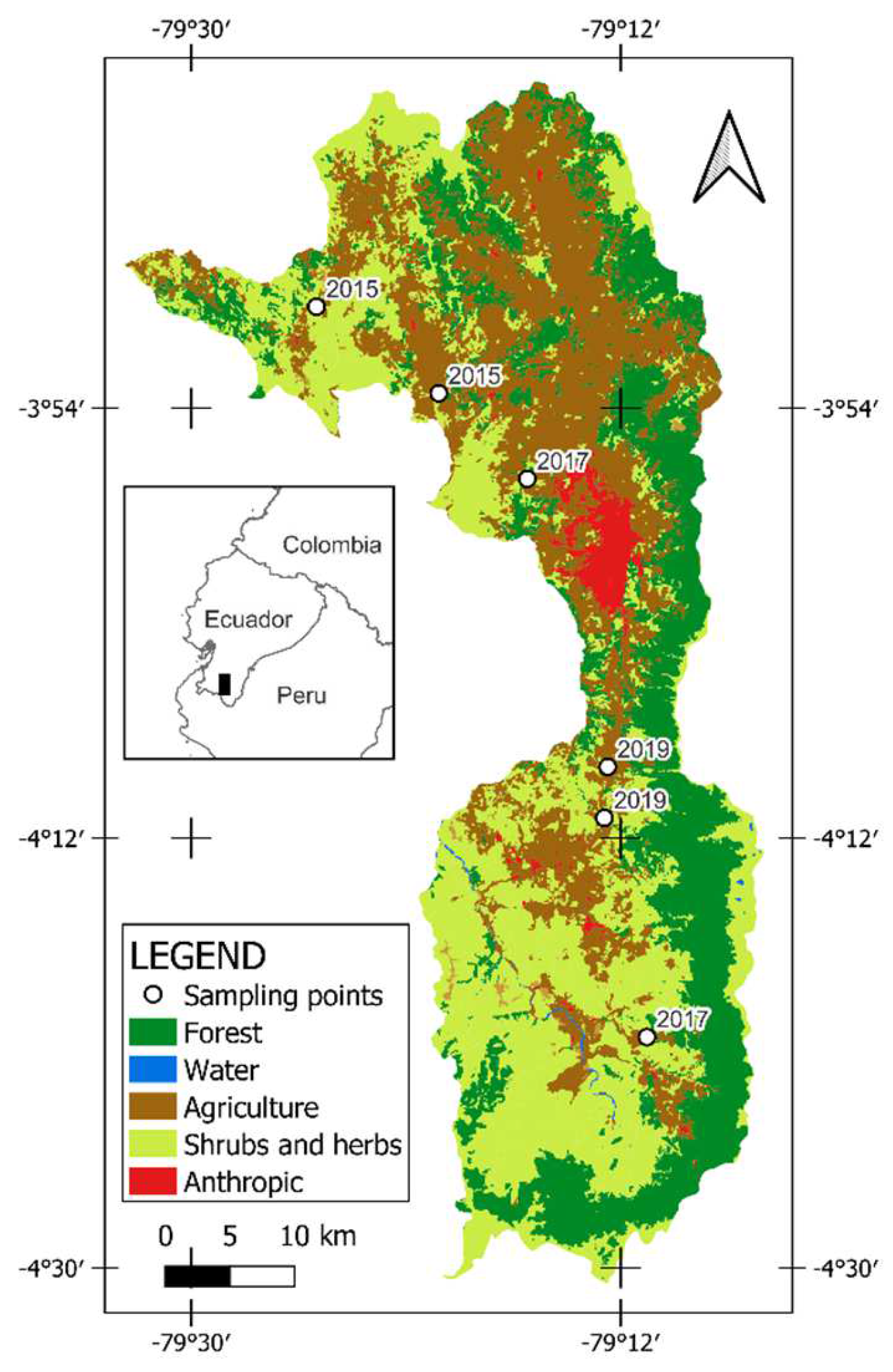
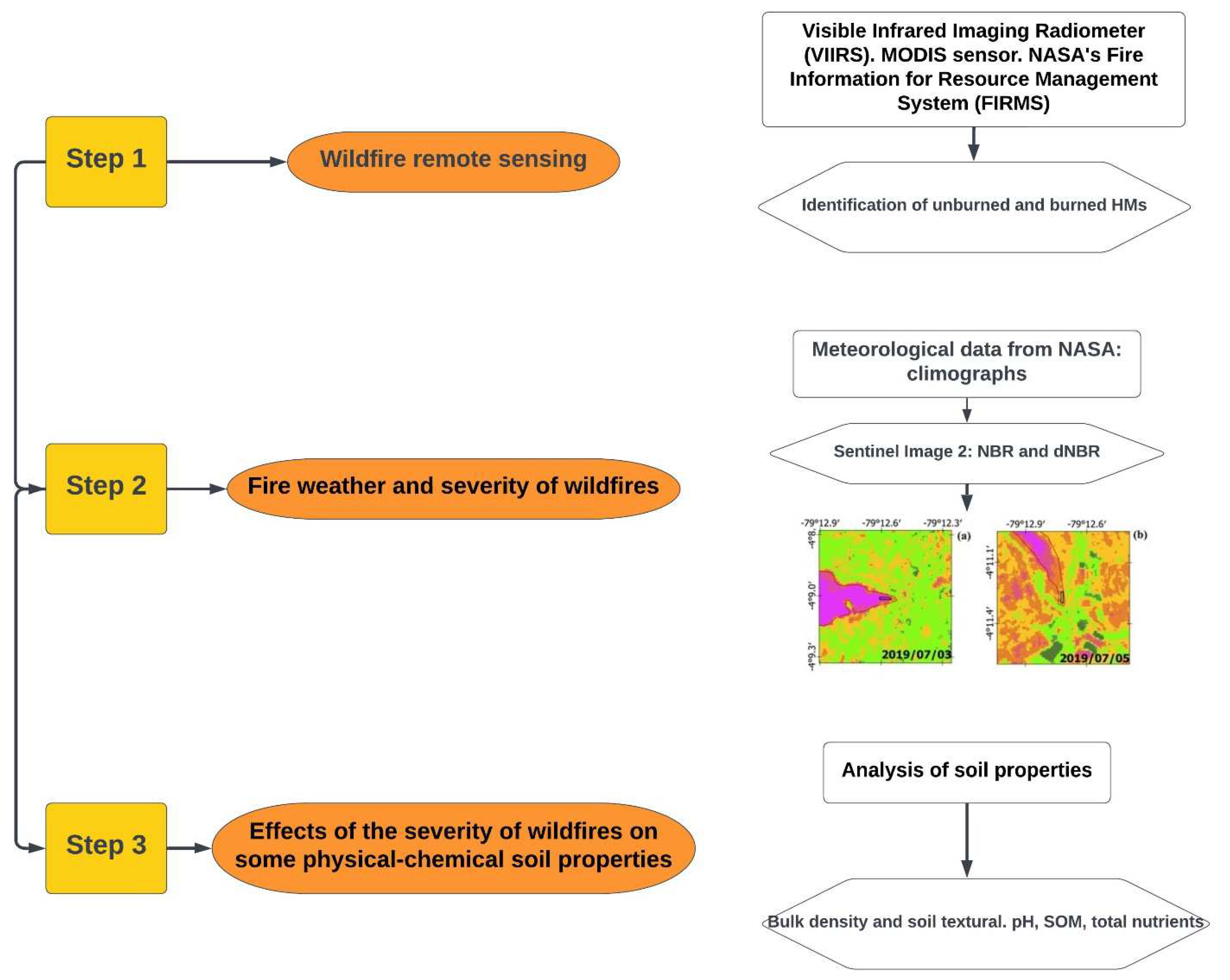
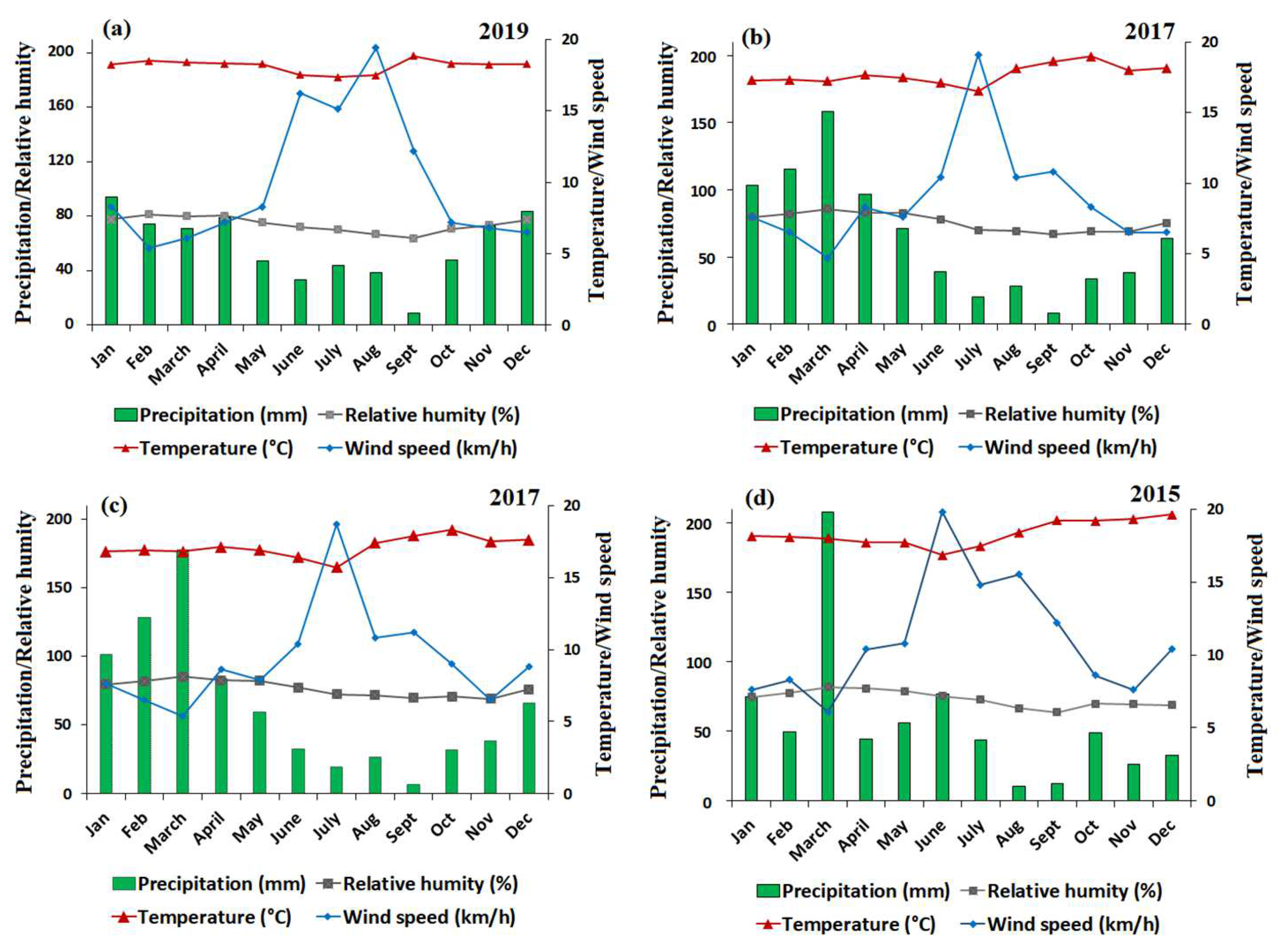
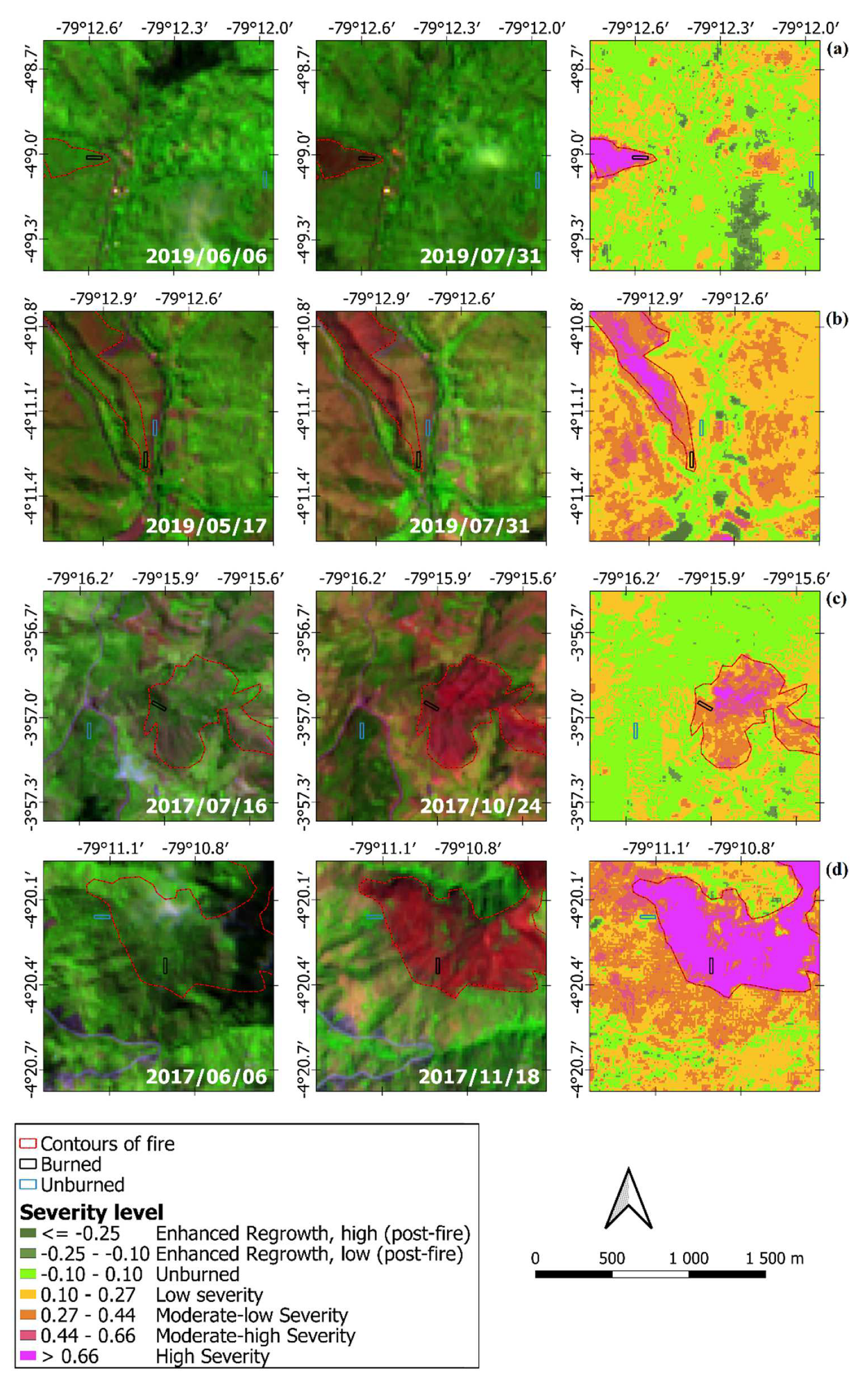
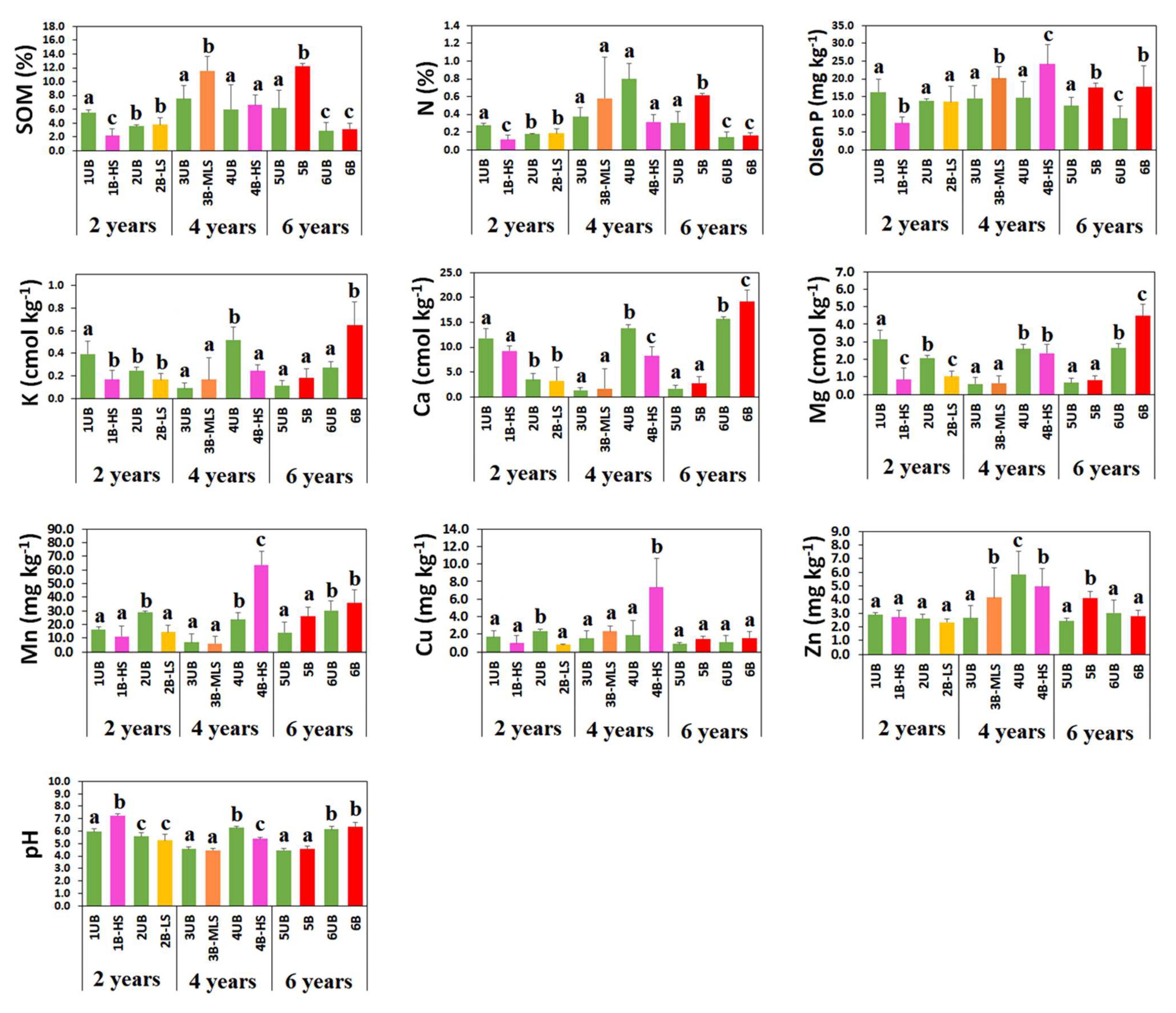
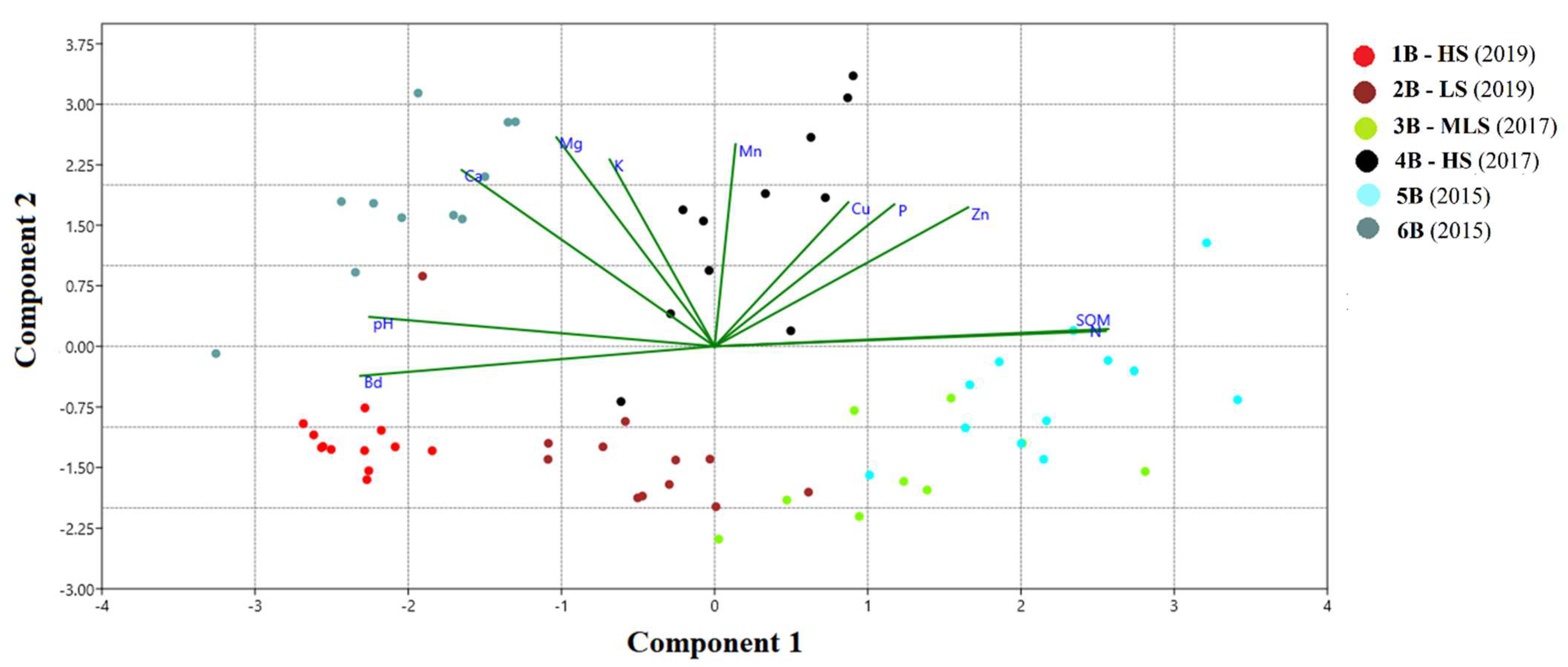
| Study Site/Year | Time Since Fire (Years) | Fire Occurrence | Plot Code | Coordinates | Altitude (m) | Vegetation Cover | Slope of the Land |
|---|---|---|---|---|---|---|---|
| 1/2019 | 2 | Unburned | 1UB | 4° 9′5.62″ S 79°11′42.31″ W | 1997 | 75% shrub, 20% grass, 5% tree. | >70% |
| Burned high severity | 1B-HS | 4° 9′1.76″ S 79°12′34.93″ W | 1822 | ||||
| 2/2019 | 2 | Unburned | 2UB | 4°11′17.91″ S 79°12′43.37″ W | 1665 | 50% shrub, 35% grass, 15% tree. | >70% |
| Burned low severity | 2B-LS | 4°11′9.46″ S 79°12′41.24″ W | 1660 | ||||
| 3/2017 | 4 | Unburned | 3UB | 4°20′9.58″ S 79°11′7.66″ W | 2066 | 60% shrub, 30% grass, 10% tree. | >70% |
| Burned | 3B-MLS | 4°20′19.90″ S 79°10′54.31″ W | 2220 | ||||
| 4/2017 | 4 | Unburned | 4UB | 3°57′2.91″ S 79°16′9.96″ W | 2620 | 75% shrub, 20% grass, 5% tree. | >70% |
| Burned high severity | 4B-HS | 3°56′55.29″ S 79°15′55.29″ W | 2658 | ||||
| 5/2015 | 6 | Unburned | 5UB | 3°49’28.83″ S 79°24’50.53″ W | 2313 | 50% shrub, 25% grass, 25% tree. | >70% |
| Burned | 5B | 3°49′44.95″ S 79°24′45.06″ W | 2320 | ||||
| 6/2015 | 6 | Unburned | 6UB | 3°53′31.97″ S 79°19′34.98″ W | 2150 | 50% shrub, 25% grass, 25% tree. | >70% |
| Burned | 6B | 3°53′22.65″ S 79°19′37.73″ W | 2187 |
| Year | Plot Code | Bulk Density | Sand | Silt | Clay | Textural Class |
|---|---|---|---|---|---|---|
| (g cm−3) | % | % | % | |||
| 2019 | 1UB | 1.1 ± 0.1 a | 61.6±1.0 a | 18.0 ± 0.0 a | 20.4 ± 1.0 a | Sandy loam |
| 2019 | 1B-HS | 1.4 ± 0.1 c | 72.5 ± 0.3 b | 14.9 ± 0.0 a | 12.6 ± 3.0 b | Sandy loam |
| 2019 | 2UB | 1.3 ± 0.2 b | 71.6 ± 3.0 b | 15.0 ± 3.0 a | 13.4 ± 0.0 b | Sandy loam |
| 2019 | 2B-LS | 1.1 ± 0.1 a | 69.6 ± 1.0 b | 16.0 ± 0.0 a | 14.4 ± 1.0 b | Sandy loam |
| 2017 | 3UB | 0.9 ± 0.2 a | 64.6 ± 6.0 a | 14.0 ± 2.0 a | 21.4 ± 8.0 a | Sandy loam |
| 2017 | 3B-MLS | 0.8 ± 0.3 c | 79.0 ± 3.6 b | 9.4 ± 3.5 a | 11.5 ± 0.1 a | Sandy loam |
| 2017 | 4UB | 1.2 ± 0.2 b | 72.5 ± 3.0 a | 16.9 ± 0.0 a | 10.6 ± 3.0 a | Sandy loam |
| 2017 | 4B-HS | 1.1 ± 0.1 b | 64.0 ± 0.6 a | 19.4 ± 1.5 a | 16.5 ± 0.9 a | Sandy loam |
| 2015 | 5UB | 1.0 ± 0.2 a | 64.6 ± 6.0 a | 14.0 ± 2.0 a | 21.4 ± 8.0 a | Sandy clay loam |
| 2015 | 5B | 0.8 ± 0.1 b | 74.6 ± 4.0 b | 10.0 ± 4.0 a | 15.4 ± 0.0 a | Sandy loam |
| 2015 | 6UB | 1.1 ± 0.1 a | 66.6 ± 2.0 a | 13.0 ± 1.0 a | 20.4 ± 1.0 a | Sandy loam |
| 2015 | 6B | 1.1 ± 0.1 a | 67.6 ± 1.0 a | 10.0 ± 0.0 a | 22.4 ± 1.0 a | Sandy clay loam |
Publisher’s Note: MDPI stays neutral with regard to jurisdictional claims in published maps and institutional affiliations. |
© 2022 by the authors. Licensee MDPI, Basel, Switzerland. This article is an open access article distributed under the terms and conditions of the Creative Commons Attribution (CC BY) license (https://creativecommons.org/licenses/by/4.0/).
Share and Cite
Carrión-Paladines, V.; Hinojosa, M.B.; Jiménez Álvarez, L.; Reyes-Bueno, F.; Correa Quezada, L.; García-Ruiz, R. Effects of the Severity of Wildfires on Some Physical-Chemical Soil Properties in a Humid Montane Scrublands Ecosystem in Southern Ecuador. Fire 2022, 5, 66. https://doi.org/10.3390/fire5030066
Carrión-Paladines V, Hinojosa MB, Jiménez Álvarez L, Reyes-Bueno F, Correa Quezada L, García-Ruiz R. Effects of the Severity of Wildfires on Some Physical-Chemical Soil Properties in a Humid Montane Scrublands Ecosystem in Southern Ecuador. Fire. 2022; 5(3):66. https://doi.org/10.3390/fire5030066
Chicago/Turabian StyleCarrión-Paladines, Vinicio, María Belén Hinojosa, Leticia Jiménez Álvarez, Fabián Reyes-Bueno, Liliana Correa Quezada, and Roberto García-Ruiz. 2022. "Effects of the Severity of Wildfires on Some Physical-Chemical Soil Properties in a Humid Montane Scrublands Ecosystem in Southern Ecuador" Fire 5, no. 3: 66. https://doi.org/10.3390/fire5030066
APA StyleCarrión-Paladines, V., Hinojosa, M. B., Jiménez Álvarez, L., Reyes-Bueno, F., Correa Quezada, L., & García-Ruiz, R. (2022). Effects of the Severity of Wildfires on Some Physical-Chemical Soil Properties in a Humid Montane Scrublands Ecosystem in Southern Ecuador. Fire, 5(3), 66. https://doi.org/10.3390/fire5030066









